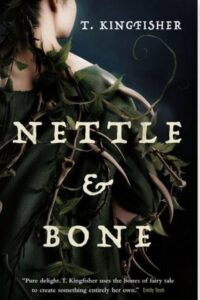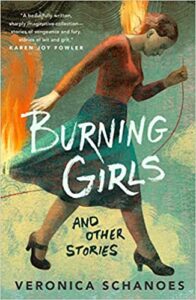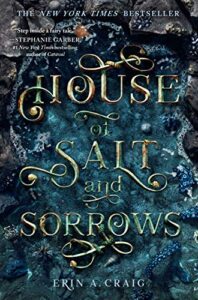Nettle & Bone by T. Kingfisher
Tor, 2023
ISBN-13 978-125024404
Available: Hardcover, paperback, Kindle edition, audiobook.
Buy: Bookshop.org | Amazon.com
There is a thin line between fantasy and horror, and between YA and adult fiction. Nettle and Bone dances on that line in this dark fairytale by T. Kingfisher, closer in tone to The Seventh Bride than The Hollow Places.
Marra is the youngest of three sisters, princesses of the Harbor Kingdom, which is surrounded on both sides by more powerful kingdoms. Her oldest sister Damia died after a suspiciously short marriage to the cruel Prince Vorling, and now her middle sister, Kania, must marry him and bear him an heir. Vorling’s heir will receive a blessing from the royal family’s fairy godmother that no foreign enemy can harm them with magic, but their lives are bound to the godmother’s just as she is bound to their family.
Marra is hidden away at a convent where she stays for ten years, until a visit to her sister convinces her that Kania must be freed from her abusive husband. She goes to the dust-wife, a witch skilled in necromancy, who owns a demon chicken, to ask for help, and accomplishes three impossible tasks the dust-wife sets her, including spinning, weaving, and sewing a cloak of nettle wool and bringing a dog made of bones to life. In completing the tasks. the dust-wife’s promise forces her to help Marra on her quest. They visit a goblin market to find what they need to succeed, which turns out to be a disgraced warrior, Fenris, who was trapped in a fairy fort. They then find Marra’s own fairy godmother, who turns out to be better at cursing than blessing, to her shame. They all must go into the catacombs under Vorling’s castle, where old kings are laid to rest, so the dust-wife can raise the king who bound the royal family’s godmother(essentially a prisoner) and force him to release her, Marra’s fairy godmother can take her place, and Fenris can kill the king.
I appreciated the imperfections in the characters and in the relationship between Kania and Marra that made them interesting and unique. Fairytale characters are usually flat and the storylines formulaic, but Kingfisher subverts expectations with fleshed-out characters and plot elements that bring the unpredictable into play using familiar structures. As it just won the Hugo and Nebula Awards for best novel, I am clearly not the only one to recognize that this book is really something special. Highly recommended.
Reviewed by Kirsten Kowalewski







Follow Us!